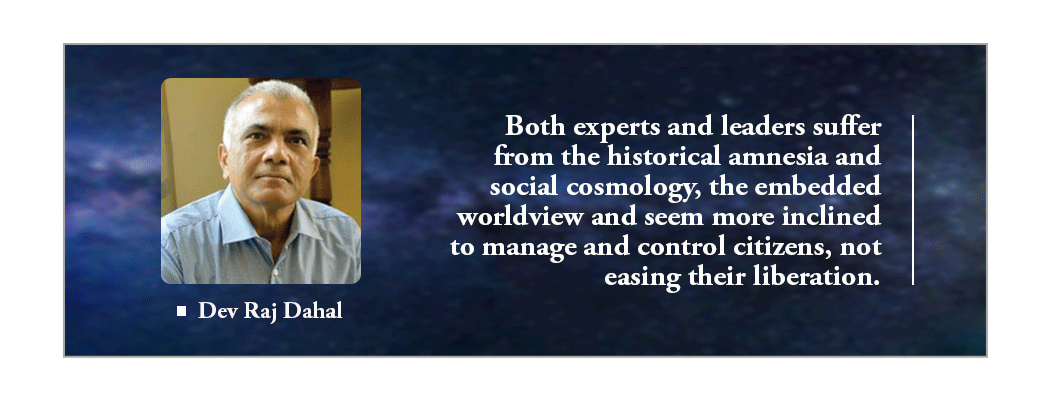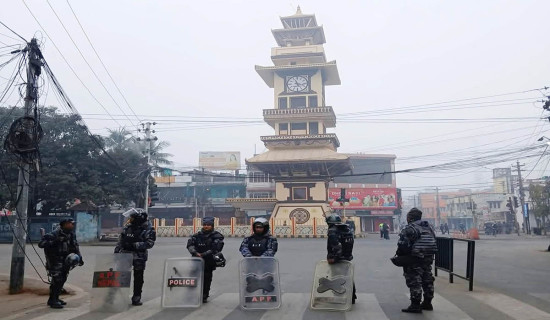- Wednesday, 7 January 2026
Citizens Transcending Partisan Politics
The problem that roil around the brain of attentive Nepali citizens now is the gap between political wisdom of leaders to plan for the nation’s better future and stalemated party machine, between partial knowledge of experts and interconnected problems, between indigenous insights and external ideology-based social sciences and between the strong grip of feudalism and accelerating scientific innovation affecting thinking, work and action. The future-conscious Nepali citizens find an imbalance between lawful division of power and partisan lure of leaders to free-ride over the entire life-world. They know that the mediating aspects are of little consequence while political cleavages are foretelling one after another crisis, not inclusive transformation of political culture of the nation for governmental stability.
Nepali citizens have known about the future through the past pattern of events, such as from the cycle of weather or cause-effect theory expressed in spiritual treatises. Their curiosity about the future events engaged them in knowing about the evolution of the empirical and normative world. They were sensitive to change as per society’s needs, not only driven by selfish rights-oriented wishes. Citizens had learned ethics to conquer bellicose conduct, skill for division of labour and common sense to see the future in terms of unsettled problems. Unlike the great majority of leaders driven by partisan consideration or disciplinary experts gripped in what Herbert Simon calls “bounded rationality,” of their knowledge system, the approach of future-conscious Nepali citizens is holistic as they anticipate the consequence of their actions in karmaic cycle.
Historical amnesia
Both experts and leaders suffer from the historical amnesia and social cosmology, the embedded worldview and seem more inclined to manage and control citizens, not easing their liberation rooted in native belief of nirvana as a critique of knowledge, power and fatalism and reconciled faith with reason. The synergy was internalised by Nepali organic intellectuals’ discursive practice, shastrartha. Attentive Nepali citizens since ancient times have used sampling while cooking food by picking up a tiny piece from the boiling pot, peasants have used weather forecasts for the planting of sapling, cultivation and harvesting of crops and even adapted their cultural festivals to fit it.
Astrologers prepared their own charts for the eclipse of sun and moon and actions of stars with precision and their effects on human lives. They opened universal sensation in self through the light of yoga and saw the future with the grasp of new connections and possibilities. It widened their gaze to the cosmic nature. It spans all faiths, science, identities, ideology and politics. Nepali sages versed in classical treatises often refer to Yudhistir entreating lord Krishna to stop Mahabharat war while the latter’s response was that the causes of war are copious. He cannot circumvent the effects of the causes, only a just war can clean it and thus prompted Arjun to wage just war against Kauravs running unfair statecraft.
Gautam Buddha too applied the methodology of description, explanation, prediction and causal relationship of karmaic effect. Many visionary sages of the nation applied their hunches and guesses and anticipated the problems and their solutions. They had used worthwhile historical and empirical insight, learning by resolving problems, applying logic and engaging in discourse to refine reason and rationality. Future-conscious Nepali citizens are anticipatory in imagination, thinking, planning and adaptable to the age of accelerating changes. They catalyse social energy and will, transform the self and others, widen mental horizons and perspectives and are motivated to move the society and the nation forward for safe adaptation.
As consciousness involves improving the cognitive understanding and emotional abilities, processes and experiences, Nepali citizens have utilised these resources in dealing with the future events either induced by politics, economy, technology, climate change, geopolitical tussle or war or exhibited the range of ken far ahead of their leaders. Autonomous media and critical intellectuals have electrified citizens against the nation’s persistent maladies such as lingering transitional justice, corruption, political instability, misuse of human rights and economic ills. They are invoking the constitutional right to know and distributive justice. If a bulk of citizens knows little about meta issues, it amounts to a lack of proper civic education to them by the media, party schools, civil society and the failure of the educational system.
Nepali democracy needs sound public knowledge to spur enlightened political action and avert corporations with their spin doctors’ tendency to easily manipulate the egalitarian impulse of democracy. Nepali citizens constantly require a mechanism of due diligence and a passion for inter-subjective knowledge so that certain goods that are public are not privatised by elites. Obviously future-conscious citizens are active, partisan-free, contextual in understanding public policies, reflexive to enlarge debate in all spheres of national life, reflective about the conditions of their existence and pluralistic lens, not adversarial. The positive point is their increasing concern about public and political discourse about the nation’s prospects. One can discover this mood in their letters to the editors in the mainstream media, social media comments and commentaries in the radios.
The other point manifests in the common experience of how Nepali citizens are gradually transcending the centralised political spectrum of left-right-centre and optimising the solution of their problems in a decentralised manner. Their voting behaviour indicates that they are increasingly becoming less partisan in attachment and more public in orientation. They know many of their problems they face whether at personal, institutional, societal and nation-state levels require scaling up of political perspective, building solidarity and corresponding actions towards improvements in technological use, working patterns, economy, health and education and international relations. Obviously, when the world's mighty powers are in a state of rivalry, a small state like Nepal which values its freedom of manoeuvre must stay out of it, to pay tribute to its own independence.
Nepali citizens have become more critical and judgmental about political power now than before. If national leaders do not engage citizens in the vital choices they make and beseech them to get involved in the long-term policies they will simply swing from the pole of power to a pole of indifference. In this sense, Nepali constitution is a vital compass to synchronise the conduct of leaders and citizens to navigate the safe future beyond the dull geopolitics. Interconnected problems can be solved by collaborative action. Climate change inducing unsustainable stress on ecosystems is one example. The green movement of Nepal, or politics of Kalapathar or an awareness of the erosion of the ecological resilience of Chure hills by deforestation and over exploitation of natural resources has wider resonance.
Citizens realise that the nation has also lost genetic diversity and depleted the water table. Technology alone cannot retrieve the loss of natural capital without a circular economy and implementation of the SDGs. It also entails a shift in the balance from the government to the market and community now. The survival of citizens in a Nepal Mandala rests on respecting nature’s self-creative potential, self-regenerating eco-system of amazing intricacy and harnessing citizens' site of coexistence and co-efficiency. Imperfect socialisation by political parties, identity-crazy groups and rival media has presented negative feedback in politics and weakened the immune system of democracy. Civic education of Nepalis about the sovereignty embedded in them can enable them to know their rights, assume responsibilities and put off popular sovereignty, a contested site of politics.
Future conscious Nepali citizens increasingly demand for participation, representation, ownership and stake in the polity to postpone their alienation, apathy and cynicisms associated with maladaptive politics and desire to level up the condition of their existence marred by mass poverty, unemployment, migration, burden of debt, inflation, livelihood crisis and cultural erosion life. It is vital to protect future generations, now mostly migrant workers, against the worst case-scenario and utilise their newly learned entrepreneurship for opportunity. Most of the problems outlined above are the consequences of awful management and deficiency of forethought as Nepali society’s best brains are either denied or drained by the political class to serve the nation or saturated by project works of external agencies.
Social inclusion
As ordinary citizens find their lives nfused with media, economy and politics-socialised crises, they realise the loss of choice and freedom in their personal lives. The heads of most constitutional bodies do not represent inclusive culture vital to realise the constitutional vision of an egalitarian future. Social inclusion is essential to the integration and maintenance of democratic system in the nation. Disharmony of the constitutional spirit may generate the goal conflict of democracy with its societal sub-systems and become a sign of risk for a stable future. Only inclusiveness can enforce the accountability of citizens and creates a political order despite power differentials of various social classes.
It also enables future-conscious Nepalis to overcome the problems of collective action arising out of their empirical divisions by political parties and the constitution on the basis of age, gender, class, caste, region, ethnicity, religion and profession.
The relative success of the federations of community forestry, irrigation, local government, Guthi, sugarcane farmers, among others, can be attributed to public action above primordial identities. What makes conflict resolution possible is the shared interest of citizens for peace. They built negotiated consensus on matters of their common interests through education, socialisation and an awareness of a shared future. Social mediation on the basis of deliberation, the ethos of ethics and justice of dharma and merit of the issues have not lost lustre over the logic and litigation. Peace with justice, freedom and extirpation of all future sources of conflicts can be achieved in a shared democratic frame, not only a power equation that imposes its will on powerless.
(Former Reader at the Department of Political Science, TU, Dahal writes on political and social issues.)

















